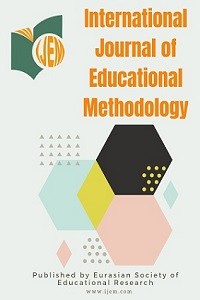Araştırma Makalesi
Yıl 2018,
Cilt: 4 Sayı: 3, 153 - 160, 15.08.2018
Öz
The aim of this study is to investigate teachers’ perceptions about the importance of learning innovation toward critical thinking ability in learning mathematics. The subjects in this study are the teachers and the students of grade Vin Al-Islam 6 Al-Fajar, Muhammadiyah 23 and Cokroaminoto Islamic Elementary School Surakarta. The research method used in this research is qualitative case study. The problem in the research is the students' mathematics score is low that is seen from the results of the daily test’s students which showed 85% get grades below the minimal mastery criteria there is 60. The analysis technique used is triangulation. Validation used is qualitative descriptive. Based on the results of interviews to a number of teachers who teach mathematics in the fifth-grade in Pasarkliwon sub-district, it can be concluded that students' critical thinking ability in mathematics is low so that it is required innovative learning model used by the teachers.
Anahtar Kelimeler
nnovative learning model critical thinking ability Mathematics teachers' perceptions
Kaynakça
- Abidin, Y. (2014). Desain sistem pembelajaran dalam konteks kurikulum 2013 [Learning System Design in the Context of 2013 Curriculum]. Bandung : Refika Aditama.
- Afidah., & Khairunnisa.(2016). Matematika Dasar [Basic Mathematic]. Jakarta: PT Raja Grafindo Persada.
- Arı, A., & Katranci, Y. (2013). The opinions of primary mathematics student-teachers on problem based learning method. Procedia–Social and Behavioral Sciences, 116, 1826-1831.
- Dehghania, M., Mirdoraghib, F., & Pakmehr, H. (2011). the role of graduete student’s achievement goals in their critical thinking disposition. Elsevier: Procedia Social and Behavior, 15 (2011), 2426-2430
- Farikhin. (2010). Mari Berpikir Matematis :Panduan Olimpiade Sains Nasional SMP [Let's Think Mathematically: Guide to the National Science Olympic of Senior High School]. Yogyakarta: Graha Ilmu.
- Heruman. (2018).Model Pembelajaran Matematika di Sekolah Dasar [Mathematics Learning Model in Primary Schools]. Bandung: PT Remaja Rosdakarya.
- Hosnan, M. (2014)Pendekatan Saintifik dan Kontekstual dalam Pembelajaran Abad 21 [Scientific and Contextual Approach in 21st Century Learning]. Bogor : Ghalia Indonesia
- Nugroho, A. (2016). HOTS (Kemampuan Berpikir Tingkat Tinggi, Konsep, Pembelajaran, Penilaian , Penyusunan Soal Sesuai HOTS [HOTS (High-Level Thinking Ability, Concept, Learning, Assessment, Questions Preparation based on HOTS)]. Jakarta: PT Gramedia Widiasarana Indonesia.
- Rusmono. (2017). Strategi Pembelajaran dengan Problem Based Learning . Bogor: Penerbit Ghalia Indonesia.
- Salihu. (2018). Mathematics skills of kosovar primary school children: a special view on children with mathematical learning difficulties. International Electronic Journal of Elementary Education, 10(4), 421-430.
- Shoimin, A. (2014). 68 Model Pembelajaran Inovatif dalam Kurikulum 2013 [68 Innovative Learning Models in 2013 Curriculum]. Yogyakarta: AR- Ruzz Media
- Sugiyanto. (2007) Modul Pendidikan dan Latihan Profesi Guru (PLPG): Model-model Pembelajaran Inovatif [Professional Teacher Education and Training Module (PLPG): Innovative Learning Models]. Surakarta: Panitia Sertifikasi Guru Rayon 13 Surakarta.
- Sugiyono. (2017). Metode Penelitian Pendidikan Pendekatan Kuantitatif, Kualitatif, dan R&D [Educational Research Methods of Quantitative, Qualitative and R&D Approaches] . Bandung: CV Alfabeta.
- Winantaputra. (2010).Buku Pedoman Sertifikasi Pendidik untuk Dosen Tahun 2010 [Guidebook for Educator Certification for Lecturers in 2010]. Jakarta: Kemendikbud.
- Wulandaril. (2017). Students’ Critical thinking improvement through PDEODE and STAD combination in the nutrition and health lecture. International Electronic Journal of Elementary Education, 6(2), 110-116.
Yıl 2018,
Cilt: 4 Sayı: 3, 153 - 160, 15.08.2018
Öz
Kaynakça
- Abidin, Y. (2014). Desain sistem pembelajaran dalam konteks kurikulum 2013 [Learning System Design in the Context of 2013 Curriculum]. Bandung : Refika Aditama.
- Afidah., & Khairunnisa.(2016). Matematika Dasar [Basic Mathematic]. Jakarta: PT Raja Grafindo Persada.
- Arı, A., & Katranci, Y. (2013). The opinions of primary mathematics student-teachers on problem based learning method. Procedia–Social and Behavioral Sciences, 116, 1826-1831.
- Dehghania, M., Mirdoraghib, F., & Pakmehr, H. (2011). the role of graduete student’s achievement goals in their critical thinking disposition. Elsevier: Procedia Social and Behavior, 15 (2011), 2426-2430
- Farikhin. (2010). Mari Berpikir Matematis :Panduan Olimpiade Sains Nasional SMP [Let's Think Mathematically: Guide to the National Science Olympic of Senior High School]. Yogyakarta: Graha Ilmu.
- Heruman. (2018).Model Pembelajaran Matematika di Sekolah Dasar [Mathematics Learning Model in Primary Schools]. Bandung: PT Remaja Rosdakarya.
- Hosnan, M. (2014)Pendekatan Saintifik dan Kontekstual dalam Pembelajaran Abad 21 [Scientific and Contextual Approach in 21st Century Learning]. Bogor : Ghalia Indonesia
- Nugroho, A. (2016). HOTS (Kemampuan Berpikir Tingkat Tinggi, Konsep, Pembelajaran, Penilaian , Penyusunan Soal Sesuai HOTS [HOTS (High-Level Thinking Ability, Concept, Learning, Assessment, Questions Preparation based on HOTS)]. Jakarta: PT Gramedia Widiasarana Indonesia.
- Rusmono. (2017). Strategi Pembelajaran dengan Problem Based Learning . Bogor: Penerbit Ghalia Indonesia.
- Salihu. (2018). Mathematics skills of kosovar primary school children: a special view on children with mathematical learning difficulties. International Electronic Journal of Elementary Education, 10(4), 421-430.
- Shoimin, A. (2014). 68 Model Pembelajaran Inovatif dalam Kurikulum 2013 [68 Innovative Learning Models in 2013 Curriculum]. Yogyakarta: AR- Ruzz Media
- Sugiyanto. (2007) Modul Pendidikan dan Latihan Profesi Guru (PLPG): Model-model Pembelajaran Inovatif [Professional Teacher Education and Training Module (PLPG): Innovative Learning Models]. Surakarta: Panitia Sertifikasi Guru Rayon 13 Surakarta.
- Sugiyono. (2017). Metode Penelitian Pendidikan Pendekatan Kuantitatif, Kualitatif, dan R&D [Educational Research Methods of Quantitative, Qualitative and R&D Approaches] . Bandung: CV Alfabeta.
- Winantaputra. (2010).Buku Pedoman Sertifikasi Pendidik untuk Dosen Tahun 2010 [Guidebook for Educator Certification for Lecturers in 2010]. Jakarta: Kemendikbud.
- Wulandaril. (2017). Students’ Critical thinking improvement through PDEODE and STAD combination in the nutrition and health lecture. International Electronic Journal of Elementary Education, 6(2), 110-116.
Toplam 15 adet kaynakça vardır.
Ayrıntılar
| Birincil Dil | İngilizce |
|---|---|
| Konular | Eğitim Üzerine Çalışmalar |
| Bölüm | Araştırma Makalesi |
| Yazarlar | |
| Yayımlanma Tarihi | 15 Ağustos 2018 |
| Yayımlandığı Sayı | Yıl 2018 Cilt: 4 Sayı: 3 |


